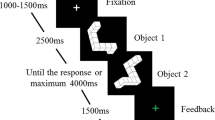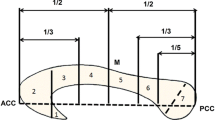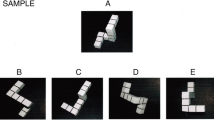Abstract
The electroencephalogram (EEG) was used to investigate variation in mental rotation (MR) strategies between males and females and different college majors. Beta activation was acquired from 40 participants (10 males and 10 females in physical science; 10 males and 10 females in social science) when performing the Vandenberg and Kuse (1978) mental rotation test (MRT). Males majoring in physical science showed increased activation over the right parietal area when performing the MRT, suggestive of a spatial/holistic strategy, while males majoring in social science showed increased activity over the left frontal region, indicative of a verbal/analytic strategy. Females, regardless of college major, showed bilateral activation, a pattern reflecting the use of a combined verbal/spatial MR strategy. These results provide evidence at the neural level that males and females, as well as physical and social science majors, are biased toward the use of different strategies when performing the MRT.
Similar content being viewed by others
References
BENBOW, C. P. (1988). Neuropsychological perspectives on mathematical talent. In L. K. Obler & D. Fein (Eds.), The exceptional brain: Neuropsychology of talent and special abilities (pp. 48–96). New York, NY: Guilford Press.
BINNIE, C. D., ROWAN, A. J., & GUTTER, T. (1982). A manual of electroencephalographic technology. Cambridge, UK: Cambridge University Press.
BRAVER, T. S., COHEN, J. D., NYSTROM, L. E., JONIDES, J., SMITH, E. E., & NOLL, D. C. (1997). A parametric study of prefrontal cortex involvement in human working memory. Neuroimage, 5, 49–62. doi: 10.1006/nimg.1996.0247
BRIGHAM, E. O. (2002). The fast Fourier transform. New York, NY: Prentice-Hall.
CASEY, M. B., & BRABECK, M. M. (1989). Exceptions to the male advantage on a spatial task: Family handedness and college major as factors identifying women who excel. Neuropsychologia, 27(5), 689–696. doi: 10.1016/0028-3932(89)90113-9
CASEY, M. B., WINNER, E., & BENBOW, C. (1993). Skill at image generation: Handedness interacts with strategy preference for individuals majoring in spatial fields. Cognitive Neuropsychology, 10(1), 57–77. doi: 10.1080/02643299308253456
CASEY, M. B., WINNER, E., BRABECK, M. M., & SULLIVAN, K. (1990). Visual-spatial abilities in art, math and science majors: Effects of sex, family handedness and spatial experience. In K. J. Gilhooly, M. T. G. Keane, R. H. Logie, & G. Erdos (Eds.), Lines of thinking: Reflections on the psychology of thought: Vol. 2. Skills, emotion, creative processes, individual differences and teaching thinking (pp. 275–294). Oxford, UK: John Wiley & Sons.
COHEN, J. D., FORMAN, S. D., BRAVER, T. S., CASEY, B. J., SERVAN-SCHREIBER, D., & NOLL, D. C. (1994). Activation of prefrontal cortex in a non-spatial working memory task with functional MRI. Human Brain Map, 1, 293–304. doi: 10.1002/hbm.460010407
COHEN, M. S., KOSSLYN, S. M., BRETIER, H. C., DIGIROLAMO., G. L., THOMPSON, W. L., ANDERSON, A. K., … BELLIVEAU, J. W. (1996). Changes in cortical activity during mental rotation: A mapping study using functional MRI. Brain, 119, 89–100. doi: 10.1093/brain/119.1.89
COLOM, R., CONTRERAS, M. J., AREND, I., LEAL, O. G., & SANTACREU, J. (2004). Sex differences in verbal reasoning are mediated by sex differences in spatial ability. The Psychological Record, 54(3), 365–372.
DAVIDSON, R. J., CHAPMAN, J. P., CHAPMAN, L. J., & HENRIQUES, J. B. (1990). Asymmetrical brain electrical activity discriminates between psychometrically matched verbal and spatial cognitive tasks. Psychophysiology, 27, 528–543. doi: 10.1111/j.1469-8986.1990.tb01970.x
DITUNNO, P. L., & MANN, V. A. (1990). Right hemisphere specialization for mental rotation in normals and brain damaged subjects. Cortex, 26, 177–188.
FENG, J., SPENCE, I., & PRATT, J. (2007). Playing an action video game reduces gender difference in spatial cognition. Psychological Science, 18(10), 850–855. doi: 10.1111/j.1467-9280.2007.01990.x
GILL, H. S., & O’BOYLE, M. W. (1997). Sex differences in matching circles and arcs: A preliminary EEG investigation. Laterality, 2, 33–48.
GILL, H. S., O’BOYLE, M. W., & HATHAWAY, J. (1998). Cortical distribution of EEG activity for component processes during mental rotation. Cortex, 34(5), 707–718.
GLUCK, J., & FITTING, S. (2003). Spatial strategy selection: Interesting incremental information. International Journal of Testing, 3(3), 293–308.
GOOTJES, L., BRUGGELING, E. C., MAGNÉE, T., & VAN STRIEN, J. W. (2008). Sex differences in the latency of the late event-related potential mental rotation effect. Neuroreport: For Rapid Communication of Neuroscience Research, 19(3), 349–353.
GOUCHIE, C., & KIMURA, D. (1991). The relationship between testosterone levels and cognitive ability patterns. Psychoneuroendocrinology, 16, 323–334.
HAENSCHEL, C., BALDEWEG, T., CROFT, R. J., WHITTINGTON, M., & GRUZELIER, J. (2000). Gamma and beta frequency oscillations in response to novel auditory stimuli: A comparison of human electroencephalogram (EEG) data with in vitro models. Proceedings of the National Academy of Sciences of the United States of America, 97, 7645–7650. doi: 10.1073/pnas.120162397
HALPERN, D. F. (2000). Sex differences in cognitive abilities. Mahwah, NJ: Lawrence Erlbaum Associates.
HARRIS, I. M., & MINIUSSI, C. (2003). Parietal lobe contribution to mental rotation demonstrated with rTMS. Journal of Cognitive Neuroscience, 15(3), 315–323.
HEIL, M., & JANSEN-OSMANN, P. (2008). Sex differences in mental rotation with polygons of different complexity: Do men utilize holistic processes whereas women prefer piecemeal ones? The Quarterly Journal of Experimental Psychology, 61(5), 683–689.
HELLIGE, J. B. (1993). Hemispheric asymmetry: What’s right and what’s left. Cambridge, MA: Harvard University Press.
HERMELIN, B., & O’CONNOR, N. (1986). Spatial representations in mathematically and in artistically gifted children. British Journal of Educational Psychology, 56(2), 150–157.
HUNT, E. (1975). Quote the raven? Nevermore! In L. W. Gregg (Ed.), Knowledge and cognition (pp. 129–158). Hillsdale, NJ: Erlbaum.
JAUŠOVEC, N., & JAUŠOVEC, K. (2008). Spatial rotation and recognizing emotions: Gender related differences in brain activity. Intelligence, 36(5), 383–393.
JORDAN, K., WÜSTENBERG, T., HEINZE, H., PETERS, M., & JÄNCKE, Z. (2002). Women and men exhibit different cortical activation patterns during mental rotation tasks. Neuropsychologia, 40(13), 2397–2408.
KALICHMAN, S. C. (1986). Horizontality as a function of sex and academic major. Perceptual and Motor Skills, 63(2, Pt. 2), 903–906.
KELLER, J. (2002). Blatant stereotype threat and women’s math performance: Self-handicapping as a strategic means to cope with obtrusive negative performance expectations. Sex Roles, 47(3–4), 193–198.
KIMURA, D. (1996). Sex, sexual orientation and sex hormones influence human cognitive function. Current Opinion in Neurobiology, 6, 259–263.
KIMURA, D. (1999). Sex and cognition. Cambridge, MA: MIT Press.
KUCIAN, K., LOENNEKER, T., DIETRICH, T., MARTIN, E., & ASTER, M. V. (2005). Gender differences in brain activation patterns during mental rotation and number related cognitive tasks. Psychology Science, 47(1), 112–131.
LAVACH, J. F. (1991). Cerebral hemisphericity, college major and occupational choices. Journal of Creative Behavior, 25(3), 218–222.
LESLIE, W. (1979). Restructuring ability and patterns of physics achievement. Perceptual and Motor Skills, 48(2), 451–458.
LI, Y., & O’BOYLE, M. W. (2008). How sex, native language, and college major relate to the cognitive strategies used during 3-D mental rotation. The Psychological Record, 58(2), 287–300.
LI, Y., & O’BOYLE, M. W. (2011). Differences in mental rotation strategies for native speakers of Chinese and English and how they vary as a function of sex and college major. The Psychological Record, 61, 2–20.
LINN, M. C., & PETERSON, A. C. (1985). Emergence and characterization of sex differences in spatial ability: A meta-analysis. Child Development, 56, 1479–1498.
MARTINO, G., & WINNER, E. (1995). Talents and disorders: Relationships among handedness, sex and college major. Brain and Cognition, 29, 66–84.
MAZOYER, B., MELLET, E., & TZOURIO, N. (2002). Visual and language area interactions during mental imagery. In A. Galaburda, S. M. Kosslyn, & Y. Christen (Eds.), The languages of the brain (pp. 179–201). Cambridge, MA: Harvard University Press.
MOODY, M. S. (1998). Problem-solving strategies used on the mental rotations test: Their relationship to test instructions, scores, handedness, and college major. Dissertation Abstracts International: Section B: Science and Engineering, 59(5-B), 2426.
MOORE, D. S., & JOHNSON, S. P. (2008). Mental rotation in human infants: A sex difference. Psychological Science, 19(11), 1063–1066.
MOORE, K. (2003). The influence of analytic and spatial memory loads on mental rotation performance in men and women (Honors thesis). Melbourne University, Australia.
OLDFIELD, R. C. (1973). The assessment and analysis of handedness: The Edinburgh Inventory. Neuropsychologia, 9, 97–113.
PAPANICOLAOU, A. C., DEUTSCH, G., BOURBON, W. T., WILL, K. W., LORING, D. W., & EISENBERG, H. M. (1987). Convergent evoked potential and cerebral blood flow evidence of task-specific hemispheric differences. Electroencephalography and Clinical Neuropsychology, 66, 515–520.
PARSONS, J. E., ADLER, T. F., & KACZALA, C. M. (1982). Socialization of achievement attitudes and beliefs: Parental influence. Child Development, 53, 310–321.
PODZEBENKO, K., EGAN, G. F., & WATSON, J. (2005). Real and imaginary rotary motion processing: Functional parcellation of the human parietal lobe revealed by fMRI. Journal of Cognitive Neuroscience, 17(1), 24–36.
PRABHAKARAN, V., SMITH, J. A. L., DESMOND, J. E., GLOVER, G. H., & GABRIELI, J. D. E. (1997). Neural substrates of fluid reasoning: An fMRI study of neocortical activation during performance of the Raven’s Progressive Matrices Test. Cognitive Psychology, 33, 43–63.
QUAISER-POHL, C., GERSER, C., & LEHMANN, W. (2006). The relationship between computer-game preference, gender, and mental-rotation ability. Personality and Individual Differences, 40(3), 609–619.
QUAISER-POHL, C., & LEHMANN, W. (2002). Girl’s spatial ability: Charting the contributions of experience and attitudes in different academic groups. British Journal of Educational Psychology, 72, 245–260.
QUINN, P. C., & LIBEN, L.S. (2008). A sex difference in mental rotation in young infants. Psychological Science, 19(11), 1067–1070.
RAABE, S., HOGER, R., & DELIUS, J. D. (2006). Sex differences in mental rotation strategy. Perceptual and Motor Skills, 103(3), 917–930.
RESCHER, B., & RAPPELSBERGER, P. (1999). Gender dependent EEG-changes during a mental rotation task. International Journal of Psychophysiology, 33(3), 209–222.
RICHARDSON, J. T. E. (1991). Gender differences in imagery, cognition, and memory. In R. H. Logie & M. Denis (Eds.), Mental images in human cognition (pp. 271–303). New York, NY: Elsevier.
ROBERT, J. E., & BELL, M. A. (2000). Sex differences on a mental rotation task: Variations in electroencephalogram hemispheric activation between children and college students. Developmental Neuropsychology, 17(2), 199–223.
SHEPARD, R. N., & METZLER, J. (1971). Mental rotation of three-dimensional objects. Science, 171, 701–703.
SINGER, W. (1993). Synchronization of cortical activity and its putative role in information processing and learning. Annual Review of Physiology, 55, 349–374.
SKAALVIK, S., & SKAALVIK, E. M. (2004). Gender differences in math and verbal selfconcept, performance expectations, and motivation. Sex Roles, 50(3–4), 241–252.
SPRINGER, S. P., & DEUTSCH, G. (1998). Left brain, right brain: Perspectives from cognitive neuroscience (5th ed.). New York, NY: W.H. Freeman.
TAGARIS, G. A., RICHTER, W., SEONG-GI, K., PELLIZZER, G., ANDERSEN, P., UGURBIL, K., & GEORGOPOULOS, A. P. (1998). Functional magnetic resonance imaging of mental rotation and memory scanning: A multidimensional scaling analysis of brain activation patterns. Brain Research Reviews, 26, 106–112.
TAN, U., OKUYAN, M., ALBAYRAK, T., & AKGUN, A. (2003). Sex differences in verbal and spatial ability reconsidered in relation to body size, lung volume, and sex hormones. Perceptual and Motor Skills, 96(3, Pt. 2), 1347–1360.
THOMSEN, T., HUGDAHL, K., ERSLAND, L., BARNDON, R., LUNDERVOLD, A., SMIEVOLL, A. I., … SUNDBERG, H. (2000). Functional magnetic resonance imaging (fMRI) study of sex differences in a mental rotation task. Medical Science Monitor, 6(6), 1186–1196.
TZURIEL, D., & EGOZI, G. (2007). Dynamic assessment of spatial abilities of young children: Effects of gender and task characteristics. Journal of Cognitive Education and Psychology, 6(2), 219–247.
VANDENBERG, S., & KUSE, A. (1978). Mental rotations, a group test of three-dimensional spatial visualization. Perceptual and Motor Skills, 47, 599–604.
VAN GOOZEN, S. H. M., COHEN-KETTENIS, P. T., GOOREN, L. J. G., FRIJDA, N. H., & VAN DE POLL, N. E. (1994). Activating effects of androgens on cognitive performance: Causal evidence in a group of female-to-male transsexuals. Neuropsychologia, 32, 1153–1157.
VECCHI, T. (2001). Visuospatial processing in congenitally blind people: Is there a gender-related preference? Personality and Individual Differences, 30(8), 1361–1370.
VINGERHOETS, G., LANOO, E., & BAUWENS, S. (1996). Analysis of the Money Road-Map Test performance in normal and brain-damaged subjects. Archives of Clinical Neuropsychology, 11, 1–9.
VOYER, D. (1996). On the magnitude of laterality effects and sex differences in functional lateralities. Laterality: Asymmetries of Body, Brain and Cognition, 1(1), 51–84.
VOYER, D., VOYER, S., & BRYDEN, M. P. (1995). Magnitude of sex differences in spatial abilities: A meta-analysis and consideration of critical variables. Psychological Bulletin, 117, 250–270.
WALTON, G. M., & COHEN, G. L. (2003). Stereotype lift. Journal of Experimental Social Psychology, 39, 456–467.
WEISS, E., SIEDENTOPF, C. M., HOFER, A., DEISENHAMMER, E. A., HOPTMAN, M. J., KREMSER, C., … DELAZER, M. (2003). Sex differences in brain activation pattern during a visuospatial cognitive task: A functional magnetic resonance imaging study in healthy volunteers. Neuroscience Letters, 344(3), 169–172.
WILLIAMS, C. L., & MECK, W. H. (1991). The organizational effects of gonadal steroids on sexually dimorphic spatial ability. Psychoneuroendocrinology, 16, 155–176.
WINGFIELD, A. (2002). Sex differences in motivation, self-concept, career aspiration and career choice: Implications for cognitive development. In A. V. Mcgillicuddy-De Lisi & R. De Lisi (Eds.), Biology, sociology, and behavior: The development of sex differences in cognition (pp. 93–144). Greenwich, CT: Ablex.
WITELSON, D. (1976). Sex and the single hemisphere: Specialization of the right hemisphere for spatial processing. Science, 193, 425–427.
WRAGA, M., HELT, M., JACOBS, E., & SULLIVAN, K. (2007). Neural basis of stereotype-induced shifts in women’s mental rotation performance. Social Cognitive and Affective Neuroscience, 2(1), 12–19.
ZECHNER, U., WILDA, M., KEHRER-SAWATZKI, H., VOGEL, W., FUNDELE, R., & HAMEISTER, H. (2001). A high density of X-linked genes for general cognitive ability: A runaway process shaping human evolution? Trends in Genetics, 17, 697–701.
ZEGAS, J. (1976). A validation study of tests from the divergent production plane of the Guilford Structure-of-Intellect Model. Journal of Creative Behavior, 10(3), 170–177.
Author information
Authors and Affiliations
Corresponding author
Rights and permissions
About this article
Cite this article
Li, Y., O’Boyle, M. How Sex and College Major Relate to Mental Rotation Accuracy and Preferred Strategy: An Electroencephalographic (EEG) Investigation. Psychol Rec 63, 27–42 (2013). https://doi.org/10.11133/j.tpr.2013.63.1.003
Published:
Issue Date:
DOI: https://doi.org/10.11133/j.tpr.2013.63.1.003




